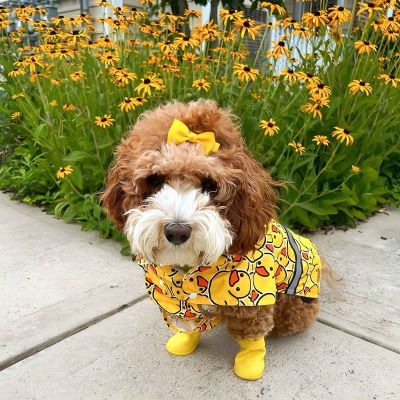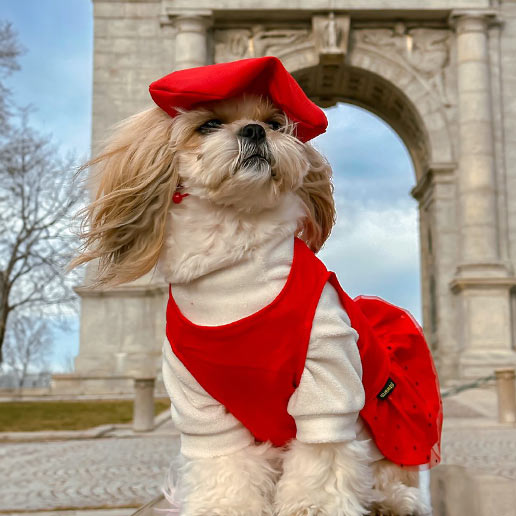How to Choose the Right Raincoat for Your Dog
Is your pup getting soaked on those wet walks? Well, we've got your back with a guide that'll help you pick the perfect raincoat for your furry friend. Think of it like choosing the best rain jacket for yourself – only this one's for your four-legged buddy. We're going to break down what to look for in a dog raincoat, from making sure it's snug and comfy to picking out materials that'll keep your dog dry. So let's get started and turn those dreary, drizzly walks into a walk in the park!

Dachshund in Waterproof Dog Raincoats
Key Features to Look For in a Dog Raincoat
When shopping for the perfect raincoat for your dog, think about how an umbrella or a good jacket keeps you dry and warm. Here are some things to keep in mind:
- Water Resistance: This one's a no-brainer! The raincoat should be made of material that doesn't let water soak through. Imagine it as a tiny shield against the rain for your dog.
- Comfort & Fit: A raincoat should fit your pup just right-not too tight and not too loose. You wouldn't wear clothes that don't fit, right? Measure your dog from their neck to their tail, and check those sizing charts before you buy.
 Instagram: twocavsandagolden
Instagram: twocavsandagolden
- Ease of Movement: Your dog should be able to move freely. They'll want to run and play even when they're wearing their coat. If it's too stiff, they won't be happy campers.
- Visibility: Shorter days mean darker walks. Coats with bright colors or reflective strips are like turning on the headlights-it helps everyone see your dog and stay safe.
- Coverage: Think about how much of your dog needs to be covered. Some coats cover the belly; others stop at the back. It depends on how much your dog likes to splash in puddles!

Instagram: teddy_cook_the_beagle
- Ease of Cleaning: After a wet walk, the last thing you want is more mess. Look for a coat that's easy to clean. If you can wipe it down or throw it in the wash, that's a win.
Understanding Material Choices and Wearability for Dog Raincoats
Selecting the best raincoat for your dog means focusing on materials that will keep them dry and comfortable in different weather conditions. Here's a closer look at why polyester, nylon, and polyurethane are top choices for your pet's outerwear.

Instagram:havanese_ted
Polyester: The Go-To Fabric for Everyday Use
Polyester is a widely used material for dog raincoats because it combines several important qualities. It's lightweight, which means your dog won't feel weighed down when wearing it. This is great for everyday walks, regardless of whether you're just around the block or heading out to the park. Polyester's water resistance is also a key feature, ensuring that rain rolls off the coat, and keeping your pet dry underneath. Its quick-drying nature comes in handy if you're going in and out during a rainy day – it'll be ready for the next outing in no time. Plus, its affordability makes it accessible for all dog owners, offering good quality without a high price tag.
Nylon: For the Active and Adventurous Dog
Nylon is tougher than polyester, making it ideal for dogs that engage in vigorous play or outdoor activities like hiking through brush and woods where they might encounter rough terrain. Its durability means it resists tearing and can handle the wear and tear of an active lifestyle. When it rains during an outdoor adventure, nylon's excellent water repellency ensures your dog stays dry even in challenging conditions. It's a reliable choice for pets who are always on the move and need gear that can keep up with their adventures.

Instagram: kimnosenchuk
Coated Fabrics: For Heavy-Duty Protection
Coated fabrics, especially those treated with polyurethane, offer enhanced protection against rain. The coating creates a barrier that prevents water from penetrating the fabric, giving your dog an additional layer of defense against heavy downpours. This makes coated raincoats perfect for long walks in steady rain or for outings to wet areas, such as the beach or lakeside paths. Even though these coats are strong against water, many options still offer some breathability to help prevent overheating.
Dogs need to stay comfortable while being protected from the rain. A breathable raincoat allows your dog's natural body heat to escape, which is crucial during energetic play or exercise. It keeps them from getting too warm, which is particularly important in warmer climates or seasons. Raincoats that highlight breathability are great for dogs who might have a lot of fur and risk overheating.

Instagram: deo_piper_cavoodles
For those dogs who love to run, jump, and embrace the outdoors fully, reinforced stitching and rip-resistant fabrics are must-haves. These materials ensure that the raincoat doesn't fall apart after a few uses and can withstand dynamic movement. Protective features like double-layered areas add longevity to the raincoat, especially over high-stress zones such as the chest and shoulders, where there's a lot of movement.
Getting Your Dog Accustomed to Wearing a Raincoat
So, you've found the perfect raincoat made from the right stuff. Now comes the potentially tricky part-getting your dog to wear it Ever noticed your dog might behave differently when they wear clothes? It's a curious thing- Some dogs might strut around like they're on a fashion show runway. Others… not so much. They might wiggle, squirm, or look at you with those big "Do I have to?" eyes. But don't worry, here are some tips to make the process smoother:
- Start Slow: Introduce the coat to your dog without putting it on them first. Let them sniff it and check it out, so it doesn't seem like a big scary monster.
- Treats, Treats, and More Treats: Use treats to create positive associations with the raincoat. Hold a treat near the headhole so they'll put their head through to grab it.

Frenchie in a Cute Duck Prints Dog Raincoat
- Keep It Short and Sweet: The first few times they wear it, keep the sessions short. Put the coat on, give them a treat, then take it off before they start to fuss.
- Praise Them Like They're Celebrities: When they're wearing the coat, talk to them in a happy voice. Tell them how good they look-as if they're the best-dressed pup at the park.
- Practice Indoors: Before you brave the rain, let them wear the coat inside. This way, they can get used to the feel without the distractions of the great outdoors.
- Make It Routine: Try to put the raincoat on at the same time during your regular walks. Dogs love routines, and this helps them know what to expect.

Instagram:nicetomeetchacha
Some dogs might take to their new outfit like a duck to water, while others need a little more convincing. Be patient, and remember that the goal is to keep your furry friend happy and dry.While protecting your dog from the rain, don't forget the big picture with these 10 essential tips for keeping your dog happy and healthy, rain or shine.
Additional Tips for Choosing Raincoats for Small-Sized Dogs
Small-sized dogs are adorable and have their own unique needs when it comes to staying dry. Let's go through some specific tips for our petite canine companions, including pugs, dachshunds, Pomeranians, cockapoos, toy poodles, and Papillon dogs:
- Pug: Pugs have a broad chest and a short body, so you'll want a raincoat with a snug fit that doesn't hang too low. Also, consider a coat with a wider neck opening to accommodate their large heads.
- Dachshund: With their long bodies and short legs, standard dog coats just won't do for these little hot dogs. Look for a raincoat that's elongated but also has a snug belly strap to keep its undercarriage protected without dragging on the ground.For those with long haired varieties, it's important to consider how their coats might be affected by the weather – owners of long haired Dachshunds may wonder about coat maintenance and whether their little hot dogs shed significantly.

Dachshund Puppy in Pink Raincoats for Dogs
- Pomeranian: Fluffy Pomeranians will need a raincoat that can cover their fur without matting it down. A lightweight and less insulated option is typically better, as their thick fur provides plenty of warmth.
- Cockapoo: These curly-coated cuties benefit from a raincoat that covers well but is easy to put on and take off to prevent tangling their curls. Adjustable straps around the neck and belly ensure a good fit for this mixed breed's varied sizes.
- Toy Poodle: Like Cockapoos, Toy Poodles have tight curls that can easily knot. A slicker matearial inside the raincoat can prevent fur matting. Moreover, since they're quite the active breed, ensure that the raincoat allows for full mobility.
- Papillon Dog: The Papillon's signature butterfly ears mean headgear is a no-no. Choose a raincoat with a fold-back hood that won't interfere with their delicate ear fringes. A lightweight model would suit their small stature and still provide enough coverage.

For all these small breeds, remember the importance of ease of movement. They might be small, but they're mighty – and they love to play and explore just like the big dogs. So, the perfect raincoat should not only keep them dry but also allow them to move freely and comfortably. And always make sure any Velcro or snaps are secure, so their little adventures don't end with a lost coat.
What to Avoid When Choosing a Raincoat for Your Small Dog
When you're picking out that snazzy new raincoat for your little buddy, there are a few no-nos you'll want to steer clear of. Here's what to watch out for to make sure your small dog stays as happy as a clam in their new gear:
- Too Much Fluff: While it might look cute, a raincoat with too much padding can be overkill for your small dog, especially if they've already got a thick coat. They could overheat, and nobody wants a hot and bothered pup.
- Complicated Closures: If it takes a rocket scientist to figure out how to put on the coat, it's probably not the best choice. Go for simple snaps or velcro that's easy to fasten, so you and your dog won't get frustrated.

Dachshund in a Cute Dog Raincoat with Frog Prints
- Draggy Bottoms: Coats that are too long can drag on the ground, especially for low-riders like Dachshunds. This can mean a wet belly and a dirty coat-not exactly what we're aiming for.
- Hoods and Ears: Hoods can be a real bother, especially for dogs with big ears or those who just don't like things on their heads. If the raincoat has a hood, make sure it's detachable or can be folded back so it doesn't annoy your furry friend.
- Straps in the Wrong Places: Be mindful of where straps and buckles lie. You don't want anything rubbing under those tiny armpits or against delicate bellies.
- Heavy Materials: Your little dog might find heavy materials cumbersome. Lightweight is the name of the game; it provides protection without weighing them down.
With the right choice, those rainy walks can turn into joyful adventures, full of sniffs and wags - minus the soggy fur!
Embracing the Rain with Your Small Dog
Take your time to find a raincoat that fits just right, matches your dog's energy, and doesn't weigh them down. At the end of the day, it's all about making sure your four-pawed pal can have a blast outdoors, rain or shine. With the right gear, every puddle they jump in will be a splash of joy instead of a mess. So go ahead, gear up your pup, and make those rainy days something to wag about!















